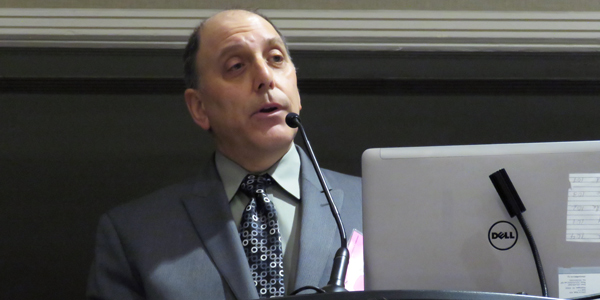By Rich Heidorn Jr.
WASHINGTON — FERC’s delay in responding to a 2017 appellate ruling vacating its order on New England transmission rates has created the risk of an endless series of “pancaked” rate cases, a panel told the Energy Bar Association’s annual meeting last week.
The D.C. Circuit Court of Appeals’ April 2017 Emera Maine ruling overturned FERC’s 2014 order setting the base return on equity for a group of New England transmission owners at 10.57%. The court said the commission failed to adequately explain why the previous 11.14% rate was unjust and unreasonable. (See Court Rejects FERC ROE Order for New England.)
“We’re in a huge amount of uncertainty right now. The Emera decision has essentially taken everything and flipped it up into the air, and now we’re all waiting to see what happens next,” said Nina Plaushin, ITC Holdings’ vice president for regulatory, federal affairs and communications. “It’s as close to a thriller as you get in doing utility regulation.”
In the 2014 ruling, the commission voted 4-0 to change the way it calculates ROEs for electric utilities, moving to a two-step discounted cash flow (DCF) process it has long used for natural gas and oil pipelines that incorporates long-term growth rates. But the commission split 3-1 over its first application of the new formula, tentatively setting the ROE for the New England TOs at three-quarters of the top of the “zone of reasonableness,” a departure from the prior practice that used the midpoint in the range (EL11-66-001). (See FERC Splits over ROE.)
FERC rejected the TOs’ argument that the commission lacked authority to change the ROE without showing it is outside the zone of reasonableness.
“There’s no protection from being in the range [of reasonableness], so any complaint can come in and [cite] a number that’s slightly lower than your number and then you’re in a hearing,” Plaushin said. “And that’s why this Emera remand is so important, because we need to figure out how we’re deciding what goes to hearing and what doesn’t. It can’t just be that I proved a number different than yours.”
Customers filed new complaints even as previous ones were still pending, she noted, because of the 15-month limit on refunds under the Federal Power Act. The clock starts on the date of the utility’s rate filing.
Plaushin said the zone of reasonableness can differ based on changes in interest rates and other inputs, or as utilities are added to or subtracted from the proxy group.
In June 2016, she noted, an administrative law judge determined 10.68% as the top of the range in a complaint against MISO TOs. This was little more than three months after another ALJ, ruling on the third complaint against the New England TOs, found the top of the range at 12.19%, with 10.9% as the midpoint.
“It just doesn’t seem to make sense. It just has to do with the fact of when they filed. … [New England] got lucky. They filed when there was a good number. And one of the things the commission will [have] to consider is: Do you really want to get into a situation where people are trying to game their ROEs by doing multiple filings just so they can track volatility?”
David E. Pomper of Spiegel & McDiarmid, who argued the Emera case for Massachusetts, predicted there will be more complaints challenging rates. “I’m certain of that,” he said. “There’s a lot of ROEs out there that are still way above the cost of equity.”
He agreed with Plaushin about the risk of a never-ending cycle of filings.
“I think that probably something we can all agree on is … if the results of the litigation changes dramatically from case to case, there’s something wrong with the way you’re reaching decisions,” he said. “That creates incentives to keep filing in the hope that you’ll get lucky.”
“The solution will be in the answer to the remand in Emera,” Plaushin said in an interview later, acknowledging FERC’s response was slowed by its loss of a quorum last year. “Hopefully that will establish better parameters, so we don’t have as many serial cases.”
Former FERC Commissioner Suedeen Kelly, a partner at Jenner & Block, who moderated the session, noted the increase in ROE challenges since 2011. The panel also featured Robert S. Kenney, Pacific Gas and Electric’s vice president of regulated affairs, who discussed the impact of ROEs on his company’s ability to adapt to distributed energy resources and protect the grid from cyber threats.






